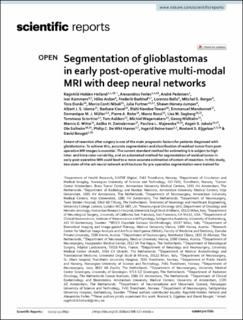| dc.contributor.author | Helland, Ragnhild Holden | |
| dc.contributor.author | Ferles, Alexandros | |
| dc.contributor.author | Pedersen, Andre | |
| dc.contributor.author | Kommers, Ivar | |
| dc.contributor.author | Ardon, Hilko | |
| dc.contributor.author | Barkhof, Frederik | |
| dc.contributor.author | Bello, Lorenzo | |
| dc.contributor.author | Berger, Mitchel S. | |
| dc.contributor.author | Dunås, Tora | |
| dc.contributor.author | Nibali, Marco Conti | |
| dc.contributor.author | Furtner, Julia | |
| dc.contributor.author | Hervey-Jumper, Shawn | |
| dc.contributor.author | Idema, Albert J. S. | |
| dc.contributor.author | Kiesel, Barbara | |
| dc.contributor.author | Tewari, Rishi Nandoe | |
| dc.contributor.author | Mandonnet, Emmanuel | |
| dc.contributor.author | Müller, Domenique M. J. | |
| dc.contributor.author | Robe, Pierre A. | |
| dc.contributor.author | Rossi, Marco | |
| dc.contributor.author | Sagberg, Lisa Millgård | |
| dc.contributor.author | Sciortino, Tommaso | |
| dc.contributor.author | Aalders, Tom | |
| dc.contributor.author | Wagemakers, Michiel | |
| dc.contributor.author | Widhalm, Georg | |
| dc.contributor.author | Witte, Marnix G. | |
| dc.contributor.author | Zwinderman, Aeilko H. | |
| dc.contributor.author | Majewska, Paulina Luiza | |
| dc.contributor.author | Jakola, Asgeir Store | |
| dc.contributor.author | Solheim, Ole Skeidsvoll | |
| dc.contributor.author | Hamer, Philip C. De Witt | |
| dc.contributor.author | Reinertsen, Ingerid | |
| dc.contributor.author | Eijgelaar, Roelant S. | |
| dc.contributor.author | Bouget, David Nicolas Jean-Marie | |
| dc.date.accessioned | 2024-01-17T09:03:50Z | |
| dc.date.available | 2024-01-17T09:03:50Z | |
| dc.date.created | 2023-11-23T11:07:38Z | |
| dc.date.issued | 2023 | |
| dc.identifier.citation | Scientific Reports. 2023, 13 (1), 18897. | en_US |
| dc.identifier.issn | 2045-2322 | |
| dc.identifier.uri | https://hdl.handle.net/11250/3112045 | |
| dc.description.abstract | Extent of resection after surgery is one of the main prognostic factors for patients diagnosed with glioblastoma. To achieve this, accurate segmentation and classification of residual tumor from post-operative MR images is essential. The current standard method for estimating it is subject to high inter- and intra-rater variability, and an automated method for segmentation of residual tumor in early post-operative MRI could lead to a more accurate estimation of extent of resection. In this study, two state-of-the-art neural network architectures for pre-operative segmentation were trained for the task. The models were extensively validated on a multicenter dataset with nearly 1000 patients, from 12 hospitals in Europe and the United States. The best performance achieved was a 61% Dice score, and the best classification performance was about 80% balanced accuracy, with a demonstrated ability to generalize across hospitals. In addition, the segmentation performance of the best models was on par with human expert raters. The predicted segmentations can be used to accurately classify the patients into those with residual tumor, and those with gross total resection. | en_US |
| dc.language.iso | eng | en_US |
| dc.publisher | Nature Portfolio | en_US |
| dc.rights | Navngivelse 4.0 Internasjonal | * |
| dc.rights.uri | http://creativecommons.org/licenses/by/4.0/deed.no | * |
| dc.title | Segmentation of glioblastomas in early post-operative multi-modal MRI with deep neural networks | en_US |
| dc.title.alternative | Segmentation of glioblastomas in early post-operative multi-modal MRI with deep neural networks | en_US |
| dc.type | Peer reviewed | en_US |
| dc.type | Journal article | en_US |
| dc.description.version | publishedVersion | en_US |
| dc.source.pagenumber | 13 | en_US |
| dc.source.volume | 13 | en_US |
| dc.source.journal | Scientific Reports | en_US |
| dc.source.issue | 1 | en_US |
| dc.identifier.doi | 10.1038/s41598-023-45456-x | |
| dc.identifier.cristin | 2200853 | |
| cristin.ispublished | true | |
| cristin.fulltext | original | |
| cristin.qualitycode | 1 | |

